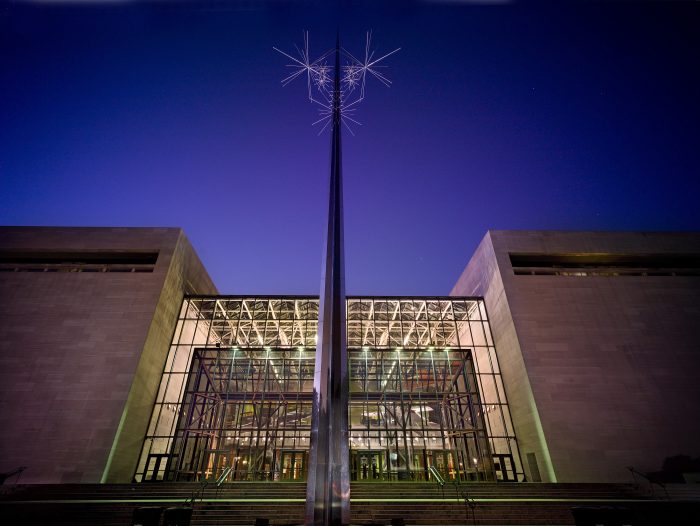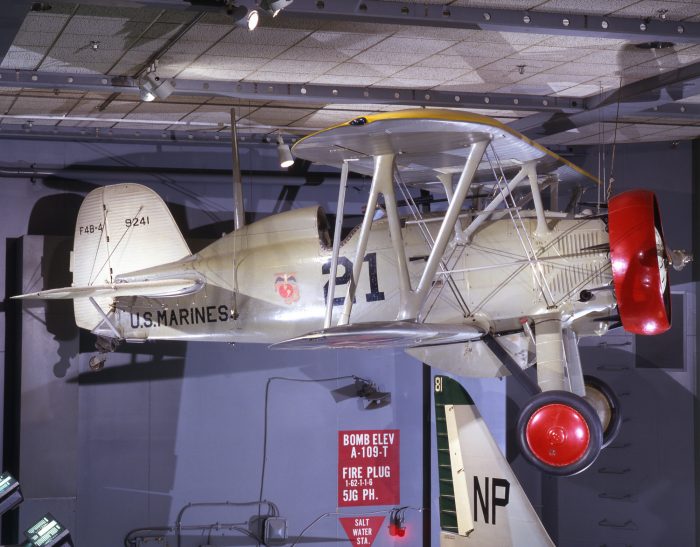After 40 years in flight, the Air and Space Museum is soaring into the future
On the 40th anniversary of the National Air and Space Museum, I sat down with its director, Gen. Jack Dailey, to talk about the future of our most popular museum.

The National Air and Space Museum’s flagship building as seen from the National Mall. Richard Lippold’s sculpture, “Ad Astra” (“To the Stars”) is in the foreground. (Photo by Eric Long)
When the National Air and Space Museum turns 40 on July 1, everyone will be invited – that is, everyone who can safely fit in the building for a public celebration, “All Night at the Museum.” NASM has been known for drawing crowds since it welcomed its one-millionth visitor just 25 days after it opened. What is its enormous appeal? I had a chance to find out recently, when director Jack Dailey and I worked a shift together at its Welcome Center. Jack has a way with visitors, and when we talked for Torch, I learned why. Jack wants to know all about them, because they are helping him and all of us plan for NASM’s future.
More than 326 million people have visited NASM’s Mall building since 1976. What is the secret of the museum’s enduring success?
Dailey: Several factors. The ways we display objects, for one. But it’s the artifacts themselves. They’re very cool.
You’re calling the Boeing Milestones of Flight Hall, which will open on the anniversary, a model for future exhibitions. Please explain.
By developing new technology for Milestones, we’ve learned to focus on how we communicate with people, during and after their visits. The artifacts – some old favorites, some new – were chosen because they connect together to communicate broad themes, which we’ll share through our new digital experience, GO FLIGHT. In 1976, artifacts were displayed with simple, short labels. We’re about to start revitalization, a complete overhaul of the building, both inside and out. It will be the new NASM. What we’re learning from Milestones is helping us plan for the 22 galleries on the drawing board.

The Apollo Lunar Module displayed as a centerpiece below the “Spirit of St. Louis” in the newly renovated Boeing Milestones of Flight Hall at the National Air and Space Museum’s flagship building on the National Mall. (Photo by Mark Avino)
What will the public be able to see during revitalization?
It will vary depending on when they visit, because the project will progress in stages. We’ll try to keep the major artifacts on view. People come to Washington to see the Wright Flyer and touch the Moon Rock. We’ll do our best to make sure they can.
What future plans are there for the Udvar-Hazy Center?
It will play an important role because it is going to provide us with swing space for artifacts and people. Even though it opened in 2003, it has been a work in progress, with flexible space in all three hangars. Attendance has steadily grown at Hazy; 2015 was our second-highest year ever.
At both of the museum’s locations, you display artifacts associated with famous pilots and space explorers. Who are some of the people visitors ask about most often?
Orville and Wilbur Wright, of course. Charles Lindbergh. The Tuskegee Airmen. And the early astronauts like John Glenn. And young people ask about Amelia Earhart, because they know her from recent movies. Kids ask about Able, the space monkey popularized in Night at the Museum: Battle of the Smithsonian. But they’re a little surprised when they see the real Able – one little girl screamed.
What are your thoughts about museum visitors of the future? Will interactive and digital technology replace artifacts, specimens, and works of art? What is the right balance?
Interactives will never replace artifacts – they are the foundation. But they complement and broaden the visitor’s experience and then allow people to stay in touch with us.
There seem to be a lot of international visitors at NASM. What do you think the Air and Space Museum communicates about our country, our ideals?
As you remember from our Welcome Center experience, we have maps printed in 11 languages. Aviation made the globe smaller and travel more practical. NASM opened on July 1 in celebration of America’s bicentennial. It was called “a gift to America” and we truly are “America’s Museum.”
As Secretary, I am not supposed to have a favorite artifact but the Sandy Koufax glove at American History is certainly right up there because it brings forth personal memories. Is there anything at Air and Space that does the same for you?
When I came to the Museum, I saw our Boeing F4B-4, a type of fighter my father had flown. It turned out he had flown the same actual aircraft, at Quantico, the year I was born. It’s my favorite.

The Boeing F4B/P-12 series served as the primary fighter of the U.S. Navy and U.S. Army Air Corps in the early 1930s, and it remained in service in numerous roles until the early 1940s. It was the last wooden-winged, biplane fighter produced by Boeing and used by the U.S. military. This particular plane was flown by Gen. Jack Dailey’s father and is the museum director’s favorite artifact at the Air and Space Museum. (NASM photo)
You’ve been here 17 years and are the museum’s longest-serving director. What is your biggest challenge? Revitalization?
Yes it is. How we’re going to get through the years of moving and rebuilding, inside and out, while remaining open, and continuing to operate the Udvar-Hazy Center and serve the public through educational activities, programs and so forth, will be a massive undertaking. It will be a challenge for all of us here at NASM but, based on the hard work and creativity already in play on the planning and prep work, we’re up to the task.
So, failure is not an option?
Failure is not an option. Gene Kranz of NASA Mission Control chose the saying for his book title to emphasize that success was critical to the space program. It’s a good slogan for us: we need to succeed for our visitors and the country.
Jack, what makes your job second-best in the world – next to mine?
I am not sure that my job is second-best.

Secretary Skorton presented Gen. Dailey, director of the National Air and Space Museum, with this T-shirt in honor of NASM’s 40th anniversary and upcoming revitalization. (Photo by Mark Avino)
Posted: 30 June 2016
-
Categories:
Air and Space Museum , From the Secretary , History and Culture , News & Announcements , Science and Nature



